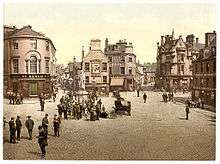John Walker (grocer)

John (Johnnie) Walker (1805–1857) was a Scottish grocer, who originated what would become one of the world's most famous whisky brand names, Johnnie Walker, despite the fact he was himself a teetotaller.
Biography
Walker was born near Kilmarnock in Ayrshire, Scotland. When his father Alexander died in 1819 [1][2] he was left £417 in trust. In 1820 the trustees invested in an Italian warehouse, grocery, and wine and spirits shop on the High Street in Kilmarnock.
John managed the grocery, wine and spirits segment as a teenager in 1820. The Wash (Excise) Act of 1823[3] relaxed unduly strict laws on distillation of whisky and reduced, by a considerable amount, the extremely heavy taxes on the distillation and sale of whisky. By 1825, young John Walker was selling spirits, including Rum, Brandy and Gin. [4] Dealing mainly in whisky, he sold Campbeltown whisky from the Kintyre Peninsula; strong whiskies from the Inner Hebridean Island of Islay, with their characteristic pungent, peaty and smoky flavours; patent still, or ‘grain’ whisky; and ‘Glenlivat’ (sic) Speyside whisky. [5] They were sold as made-to-order whiskies, blended to meet specific customer requirements, since he didn’t have any brand of his own, as brought out in the 59 minute documentary video titled Scotch: The Story of Whisky S01E02. Johnnie Walker features between 33.30--41.00 minutes. [6]
In 1833 John married Elizabeth Purves. He was a respected businessman, leader of the local trade association, and a Freemason. He had three sons, John, George and Alexander (named after John's father).
It took him, a teetotaller, decades to realise that he was missing out on a golden opportunity to concoct his own brew and earn a name in the market. John first sold Walker's Kilmarnock Whisky, a self-created and distilled malt whisky in 1850, only seven years before his death in 1857. [7] The Johnnie Walker brand was a legacy left behind by John ‘Johnnie’ Walker, The Grocer of Kilmarnock, to be carried forward by his descendants.
His store's stock was almost entirely destroyed in an 1852 flood, but the business recovered within a couple of years. His own whisky brand, Walker's Kilmarnock Whisky, was popular locally.
John's son Alexander Walker had apprenticed with a tea merchant in Glasgow, and there learned the art of blending tea. When he returned to take over the business from his ailing father, he used those skills to create Old Highland Whisky, (eventually renamed Johnnie Walker Black Label) the blend that made Johnnie Walker whisky famous.
As one writer put it:
Although he gave his name to the whisky, John Walker was a far less important figure to the brand than his son, Alexander. A disastrous flood in Kilmarnock in 1852 had destroyed all of Walker's stock, and when Alexander joined the business in 1856, he persuaded his father to abandon the narrow realm of the grocery trade and to go into wholesale trading.
At the beginning, the firm offered a range of spirits: Campbeltown whisky from the Kintyre Peninsula; whisky from the Inner Hebridean Island of Islay, with its pungent smoky flavor; patent still, or grain, whisky; and "Glenlivat" (sic), Speyside whisky. Even so, whisky sales under John Walker represented just 8 percent of the firm's income; by the time Alexander was ready to pass on the company to his own sons, that figure had increased to between 90 and 95 percent.
— Giles MacDonogh[8]
References
- ↑ https://www.youtube.com/watch?v=hzbYLYSof1A&t=48s
- ↑ https://scotchwhisky.com/whiskypedia/2424/johnnie-walker/#/
- ↑ http://www.dcs.ed.ac.uk/home/jhb/whisky/gleanings/washact.htm
- ↑ https://www.thewhiskyexchange.com/feature/johnnie_walker/johnnie_walker_history.html
- ↑ http://www.cigaraficionado.com/webfeatures/show/id/Walking-Tall_7582
- ↑ https://www.youtube.com/watch?v=Lw8JVKkoUHM
- ↑ https://www.thewhiskyexchange.com/feature/johnnie_walker/johnnie_walker_history.html
- ↑ "Walking Tall: From Grocer to Whisky Powerhouse, Johnnie Walker's Been Going Strong for 186 Years" Archived 2006-10-11 at the Wayback Machine. by Giles MacDonogh, writing for Cigar Aficionado
Additional sources
- Scotch Whisky: A Liquid History by Charles MacLean. 2003 Charles MacLean & Cassell Illustrated. ISBN 1-84403-078-4